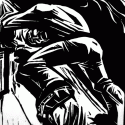Climb: Mt. Buckner-North Face
Date of Climb: 7/23/2005
Trip Report:
Jim Nelson describes the North Face of Buckner as one of the most aesthetic climbs in the North Cascades. Yet, one shouldn't be fooled by the shortness of the climb - its remote location, proximity to the largest in the North Cascades Boston Glacier and rather questionable return route makes it an attractive objective for extreme adventure seekers. To make the matter worse, one can climb this peak in late July, when it's hot and the whole mountain is out of shape.
Three of us, JustinRR, Greg and I left civilization Friday night arriving at the trailhead at foggy midnight. Next morning, awaken by the magnificent, almost gravitational view of Johannesburg slowly drifting out of the clouds, we crawled out of our cocoons, ate quick breakfast and by 9 am hit the trail.
Jim Nelson promised an interesting carry-over adventure, so we carried a small rack of rock and ice gear. At the Sahale Glacier, we've met huge crowds of hikers and climbers.
We scrambled over the top of Sahale Peak maneuvering between people and dodging falling rocks.
Yikes! - In our view, the Sahale Arm and Boston Peak - just another piles of loose unattractive rock and scree.
And as Jim Nelson describes it, the traverse around Boston Peak seems very improbable to us. The book also says - don't be cowards - just do it; so we go ahead and scramble up the small tower just below Boston Peak.
From the top of it, we can see the broken terrains of Boston Glacier and the Buckner's North Face. We stay on the ridge for a while, enjoying the exposure of unprotected climbing, and avoiding glacier travel.
In midst of late afternoon sun, we finally drop on the snow, rope up and quietly continue down the squashy slopes of Boston Glacier. Surprised by the scale of open crevasses – not much smaller than ones on Rainier, ready to swallow a large airplane, we gradually learn that traveling in the straight line is impossible. The crevasse field looked more like sand dunes with steep near vertical walls.
At late afternoon, we arrive at the base of the North Face, and chop a platform for our bivy bags in the middle of the flat snowfield. We sleep until 2 am under clear starry sky, and are ready to climb by 3am.
From the base of the climb, the North Face looks pretty broken-down and out of shape.
Although we can't see the North Face couloir, we think this line of ascent is more feasible. The only visible obstacle is the huge bergschrund at the base of the climb. We might be able to gain its steep snow ramp via the 50 feet of apparently easy rock left of the bergschrund.
Getting to the base of bergschrund was interesting and entertaining. We run belays through the jumble of bulges and irregular snow bridges, cross some water-filled crevasses and finally arrive at the base of the bergschrund.
The rock doesn't look easy anymore. Greg takes the lead climbing in crampons with very little protection. Finally, he faces vertical smooth rock. Continuing is out of questions.
Somewhat disappointed, we decide to abandon this route and try the North Face. Fortunately, we already gained some altitude and can simply traverse right onto the snow ramp of North Face. The trick is to bypass the badly crevassed lower section of the face, which we do by soloing around and over the small snowfield to the left of the main climb.
We experience some easy mixed climbing.
Few hundred feet into the climb, as we traversed right and met the North face, the slope angle increases and we begin running belays.
The snow conditions are good - mainly hard snow and water ice, some covered with volcanic sand. Most of the climb required fairly shallow frontpointing. The climb isn't very long and technically not difficult, and we do it at the enjoyable pace.
We arrive at the summit in 3 hours being greeted by fierce winds and whiteout.
Through the drifting clouds, we can barely see the sketchy perspective of the South Face, our descent route.
The South Face composed of the hard snow makes our ankles scream. Eventually, we arrive to the base of the snow and step on the scree field, which seemed to continue for miles.
This agonizing cross-country run through the Horseshoe desert eventually led to the narrow steep couloir composes mainly of loose rock and dirt, and as we hope is out last obstacle on the way to Sahale arm. Scrambling up this narrow gully wasn't fun and, in my own perspective, felt deadly.
At the top of the couloir, we realize that the fight is not over yet. Intuitively, we follow the faint "trail" up the cliff to the right of the couloir and eventually begin climbing. We pushed our way through the shaky class 4 rock arriving at the summit of something.
From there, it is only a short steep walk to the base of Sahale glacier. We happily realize that we have only 6 downhill miles to go and our blistered feet and sprained ankles aren't real troubles after all. After 16 hours of nonstop ass kicking we arrive at the parking lot feeling lucky. It seems, flies feel the same way, discovering three ready-to-eat human sandwiches.
Aftermath. The backcountry traveling part of the trip was serious, but as all three of us agreed, Buckner is un-proportionally less serious alpine objective. We are happy that we pulled it out though.
Gear Notes:
60 m rope
4 ice screws
3 pickets
extra-slings
cord
small rock-climbing rack
2 pitons
2 ice tools
Approach Notes:
Sahale
Sahale Arm
Boston Peak
Boston Glacier
Buckner NF
Buckner SF
Horseshoe Basin
Death Col
Class 4 hiking trail
Shale Glacier


